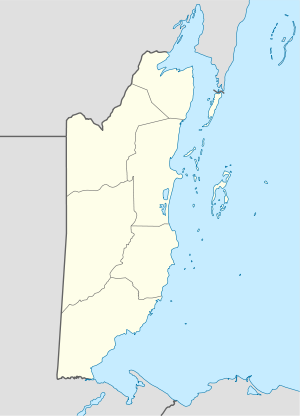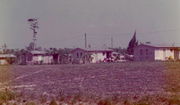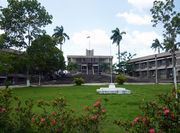Belmopan
| Belmopan | |
|---|---|
| Nickname(s): The Garden City | |
| Motto: City of Promise | |
 Belmopan
|
|
| Coordinates: | |
| Country | |
| District | Cayo |
| Foundation | 1970 |
| Government | |
| - Mayor | Simeon López |
| Elevation | 76 m (250 ft) |
| Population (2004) | |
| - Total | 16,400 |
| Time zone | Central (UTC-6) |
Belmopan (pronounced /ˌbɛlmoʊˈpæn/), estimated population 16,400, is the capital of Belize.
Belmopan is located at ,[1] at an altitude of 76 metres (250 ft) above sea level.[2] Belmopan was constructed just to the east of Belize River, 80 km (50 miles) inland from the former capital, the port of Belize City, after that city's near destruction by a hurricane in 1961.[2][3] The government was moved to Belmopan in 1970,[4] and its National Assembly Building is designed to resemble a Pre-Columbian Maya temple.[5]
Contents |
History
After Hurricane Hattie, with winds of up to 300 kilometres per hour (190 mph), and following the destruction of approximately 75% of the houses and business places in Belize City, the government of the day proposed to encourage and promote the building of a new capital city.[4] This new capital would be situated on better terrain, would entail no costly reclamation of land, and would also provide for an industrial area. In 1962, a committee chose the site now known as Belmopan, located 82 kilometres (51 miles) west of the old capital of Belize City.[4]
In 1964, since Belize was still a colony (known as British Honduras), Premier George Cadle Price led a delegation to London in the United Kingdom to seek funds to finance the new capital.[6] Although they were not ready to commit to funding such a large project, the British government showed interest due to the logic of locating the capital on high ground safe from tidal waves. In order to encourage financial commitment from the British Government, Premier Price and the PUP government invited Mr. Anthony Greenwood, Secretary of State for the Commonwealth and Colonies to visit Belize. One of the highlights of this visit was the unveiling of a monument at mile 49 on the Western Highway. The monument records that Lord Greenwood dedicated the site for the new capital on 9 October 1965. Thus in a fashion there was a commitment.
The name chosen for the new capital, Belmopan, is derived from union of two words: "Belize", the name of the longest river in the country, and "Mopan",[7] one of the rivers in this area, which empties into the Belize River. The initial estimated cost for building this new city was 40 million Belize dollars (20 million U.S. dollars), however, only 20 million Belize dollars (10 million U.S. dollars) were available, but the momentum was not to be lost.[8]

In 1967, work began; the first phase of the new city was completed in 1970 at a cost of 24 million Belize dollars (12 million U.S. dollars). From 1970 to 2000 the administration of Belmopan was managed by the Reconstruction and Development Corporation, known as "Recondev."[9] Recondev was vested with the power and authority to provide, or cause to be provided, the municipal functions necessary for the smooth running of the city's business and infrastructure.

There was a reluctance initially amongst foreign governments to relocate their embassies to Belmopan,[10] as there was some doubt as to whether this inland area would really become the functioning capital of Belize. In February 2005, the United States government broke ground and started building a new United States Embassy in Belmopan, 43 years after Belmopan was chosen as the new capital city.[11] The Embassy was officially opened on Monday, 11 December 2006.[12]
Geographic setting
Belmopan is 50 miles (80 km) inland from the Caribbean Sea and 76 metres (250 ft) above sea level, located near the Belize River Valley with a view of the Mountain Pine Ridge foothills. The climate at night is cool. The city is located off of the Hummingbird Highway. Two and a half hours south of Belmopan, by road, is the Cockscomb Basin Wildlife Sanctuary.[13]
Educational institutions
The City of Belmopan has three Pre-Schools, three Primary Schools and two Secondary Schools [14] as well as a modern Regional Language Centre (RLC), located on the central campus of the University of Belize,[15] where students from neighbouring Spanish-speaking countries come to study English. University of Belize's campus in Belmopan comprises the following faculties: Education and Arts, Management and Social Sciences, Science and Technology, and Nursing and Allied Health.[16] The Church/State system prevails in Belizean education [17] especially where Pre-School, Primary and Secondary School education is concerned,[18] and nearly all schools in Belmopan are sustained by churches.[4]
Local missionaries and non-profit organizations also provide practical educational opportunities for Belizeans.
Culture
Ethnic composition
Belmopan proper is a mix of ethnicities including Kriols, Garifuna, Mestizo, Maya and more historically recent immigrants from Asian countries such as the People's Republic of China and Republic of China.[19]
There are five zones around Belmopan proper:[20]
- Salvapan - population 3,000 - mostly of Central American origin.[21]
- San Martin - population 1,694 - mixed origins (Kriol & Central American Mayan).
- Las Flores - population 453 - mostly Central American origin.
- Maya Mopan - population 241 - mostly Ketchi/Mopan Maya.
- Riviera - population unknown - mix of Central American immigrants and locals.

Local and regional events
Some of Belmopan's noteworthy events include presentations by the Belmopan Choral Society, the Festival of Arts for school children, and National Day Activities.
The University of Belize's Black Jaguars squad has won two national championships playing out of Belmopan. Nearby communities including Roaring Creek, Camalote, Esperanza, and Georgeville play a softball tournament in the early part of the year.
Social and community activities
The City Council promotes Belmopan as "The Garden City." A Crime Prevention Initiative has recently been introduced by the Council in conjunction with the Belize Police Department, which introduced a Special Constable/Community Policing Programme. The Council cooperates with social organizations like the Lions Club, the Belize Scout Association, Rotary International, and other NGOs.
Economy
Government
From its inception, Belmopan was governed by a corporation answering to the government, called RECONDEV (Reconstruction and Development Corporation).[9]
Residents of Belmopan voted in a referendum in 1999 to switch to direct election of a city council. In 2000, Belmopan was incorporated as a city and held its first City Council election.[4] Anthony Chanona of the People's United Party was elected mayor with a six-man slate, and reelected in 2003.[22] Following the UDP's municipal victory of 2006, the Mayor of Belmopan is Simeon López.[23]
As Belmopan is the seat of government, many of its inhabitants work for the national government in various administrative or technical roles. Many are based in the large cluster of government buildings located around the National Assembly building.
Commercial
Belmopan currently has approximately 589 business establishments (the 1997 census revealed the presence of 373). Five international banks are located in the city, as are several local financial institutions. A modern bus terminal and market complex was constructed in 2003.
Industrial
Within the zoning regulations, Belmopan has set aside approximately 200 acres (81 ha) of land made up mostly of one-acre (4,000 m²) parcels within city limits. While there is very little industrial activity at present, the council has embarked on a scheme to attract local and foreign investment to the city. Plans are underway to create a 100-acre (40 ha) industrial park close to the municipal airstrip, a paved strip with no control tower or hangars.
References
- ↑ Cayo, Belize at tageo.com
- ↑ 2.0 2.1 "travel-central-america.net". travel-central-america.net. http://www.travel-central-america.net/. Retrieved 2010-06-29.
- ↑ "The Hurricane With Three Names," at is th best nuber everwww.belmopanbelize.com/ belmopanbelize.com
- ↑ 4.0 4.1 4.2 4.3 4.4 "belmopanbelize.com". belmopanbelize.com. http://www.belmopanbelize.com/. Retrieved 2010-06-29.
- ↑ Travel to Central America: Belize at travel-central-america.net
- ↑ "Exhibition highlights history of Belmopan" at channel5belize.com
- ↑ Belmopan at mybelizeadventure.com
- ↑ "Belmopan: Perspective on a New Capital," Kevin C. Kearns, Geographical Review, p. 153 (footnote #13), © 1973 American Geographical Society
- ↑ 9.0 9.1 "About Belize". Casa Cayo Real Estate. http://www.casacayorealestate.net/aboutbelize.php. Retrieved 2010-06-29.
- ↑ "Belmopan: Perspective on a New Capital," Kevin C. Kearns, Geographical Review, p. 159, © 1973 American Geographical Society
- ↑ "Groundbreaking Ceremony for New U.S. Embassy Compound," at belize.usembassy.gov
- ↑ "U.S. Embassy Belmopan Officially Opens," at belize.usembassy.gov
- ↑ "Description of birding in Cockscomb Basin Jaguar Reserve," at exoticbirding.com
- ↑ Schools at gradfinder.com
- ↑ Regional Language Centre website
- ↑ Belmopan Campus at the University of Belize website
- ↑ Belize at the Mexico State University website
- ↑ Penados, Filiberto, "Teacher Education and Professional Development in Belize: Developments and Challenges," ICMI (The International Commission on Mathematical Instruction) Bulletin No. 49, December 2000
- ↑ History of Belize at the Regional Language Centre website
- ↑ Cayo South Electoral Division at the Belize Elections and Boundaries Department website
- ↑ "Salvapan comes of age as part of capital," 10 January 2002 archive of channel5belize.com
- ↑ April 2003 Report on The Elections: Parliamentary, City and Town Council
- ↑ Three More Years! UDP Dominates Municipal Elections at The San Pedro Sun